 Hyundai Tucson: Vehicle load limit
Hyundai Tucson: Vehicle load limit
Tire and Loading Information Label
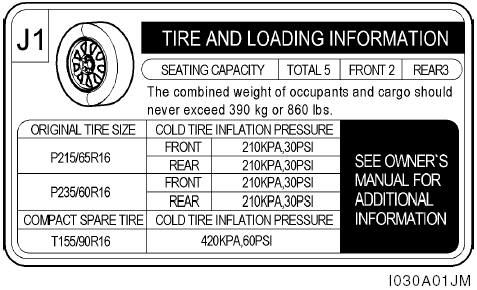 Type A
Type A
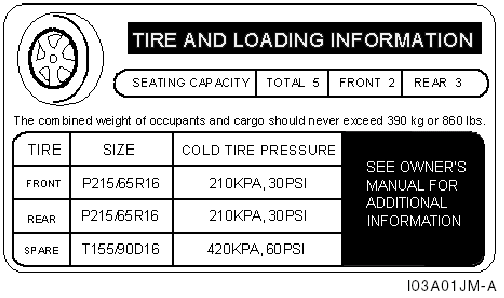 Type B
Type B
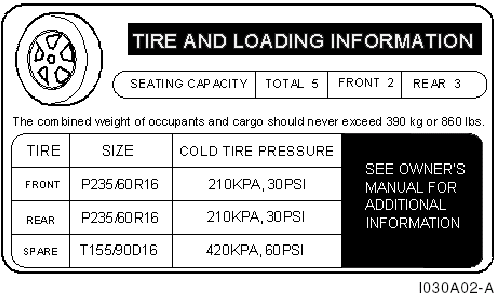 Type C
Type C
The tire label located on the driver's side of the center pillar outer panel gives the original tire size, cold tire pressures recommended for your vehicle, the number of people that can be in your vehicle and vehicle capacity weight.
Vehicle capacity weight: 860 lbs (390 kg). Vehicle capacity weight is the maximum combined weight of occupants and cargo. If your vehicle is equipped with a trailer, the combined weight includes the tongue load.
Seating capacity: Total: 5 persons. (Front seat: 2 persons, Rear seat: 3 persons). Seating capacity is the maximum number of occupants including a driver, your vehicle may carry. However the seating capacity may be reduced based upon the weight of all of the occupants, and the weight of the cargo being carried or towed. Do not overload the vehicle as there is a limit to the total weight, or load limit including occupants and cargo, the vehicle can carry.
Towing capacity: Towing capacity is the maximum trailer weight including its cargo weight, your vehicle can tow. See the section "Trailer or Vehicle Towing" for specifications about the trailer weight.
Cargo capacity: The cargo capacity of your vehicle will increase or decrease depending on the weight and the number of occupants and the tongue load, if your vehicle is equipped with a trailer.
Steps for Determining Correct Load Limit. (1)Locate the statement "The combined weight of occupants and cargo should never exceed XXX pounds'' on your vehicle's placard. (2)Determine the combined weight of the driver and passengers that will be riding in your vehicle. (3)Subtract the combined weight of the driver and passengers from XXX kilograms or XXX pounds. (4)The resulting figure equals the available amount of cargo and luggage load capacity. For example, if the "XXX" amount equals 1400 lbs, and there will be five 150 lb. passengers in your vehicle, the amount of available cargo and luggage load capacity is 650 lbs. (1400-750 (5 x 150) = 650 lbs.) (5)Determine the combined weight of luggage and cargo being loaded on the vehicle. That weight may not safely exceed the available cargo and luggage load capacity calculated in Step 4. (6)If your vehicle will be towing a trailer, load from your trailer will be transferred to your vehicle. Consult this manual to determine how this reduces the available cargo and luggage load capacity of your vehicle.
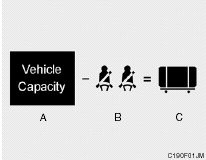 Example 1
Example 1
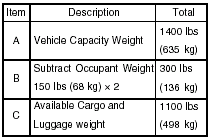
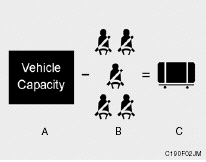 Example 2
Example 2
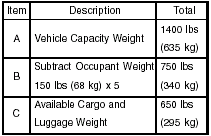
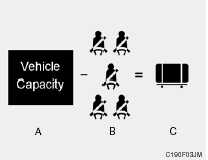 Example 3
Example 3
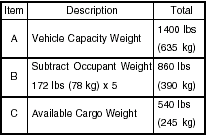
Refer to your vehicle's tire and loading information label for specific information about your vehicle's capacity weight and seating positions. The combined weight of the driver, passengers and cargo should never exceed your vehicle's capacity weight.
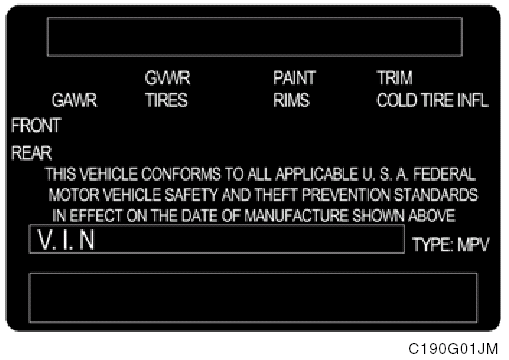 Compliance Label
Compliance Label
The compliance label is located on the driver's side of the center piller outer panel. The label shows the maximum allowable weight of the fully loaded vehicle. This is called the GVWR (Gross Vehicle Weight Rating). The GVWR includes the weight of the vehicle, all occupants, fuel and cargo. This label also tells you the maximum weights that can be supported by the front and rear axles, called Gross Axle Weight Rating (GAWR). To find out the actual loads on your front and rear axles, you need to go to a weigh station and weigh your vehicle. Your dealer can help you with this. Be sure to spread out your load equally on both sides of the centerline.
WARNING: o Never exceed the GVWR for your vehicle, the GAWR for either the front or rear axle and vehicle capacity weight. Exceeding these ratings can cause an accident or vehicle damage. You can calculate the weight of your load by weighing the items (or people) before putting them in the vehicle. Be careful not to overload your vehicle. o Do not load your vehicle any heavier than the GVWR, either the maximum front or rear GAWR and vehicle capacity weight. If you do, parts, including tires on your vehicle can break, and it can change the way your vehicle handles and braking ability. This could cause you to lose control and crash. Also, overloading can shorten the life of your vehicle. o Overloading your vehicle can cause heat buildup in your vehicle's tires and possible tire failure that could lead to a crash. o Overloading your vehicle can cause increased stopping distances that could lead to a crash. o A crash resulting from poor handling vehicle damage, tire failure, or increased stopping distances could result in serious injury or death.
NOTE: o Overloading your vehicle may cause damage. Repairs would not be covered by your warranty. Do not overload your vehicle. o Using heavier suspension components to get added durability might not change your weight ratings. Ask your dealer to help you load your vehicle the right way.
The label will help you decide how much cargo and installed equipment your vehicle can carry. If you carry items inside your vehicle – like suitcases, tools, packages, or anything else – they more as fast as the vehicle goes. If you have to stop or turn quickly, or if there is a crash, the items will keep going and can cause an injury if they strikes the driver or a passenger.
WARNING: Items you carry inside your vehicle can strike and injure people in a sudden stop or turn, or in a crash. o Put things in the cargo area of your vehicle. Try to spread the weight evenly. o Never stack items, like suitcases, inside the vehicle above the tops of the seats. o Do not leave an unsecured child restraint in your vehicle. o When you carry something inside the vehicle, secure it. o Do not drive with a seat folded down unless necessary.
 Trailer or vehicle towing
Trailer or vehicle towing
If you are considering towing with your car, you
should first check with your State's Department
of Motor Vehicles to determine their legal requirements.
Since laws vary from State to State the ...
See also:
Storing a channel
A total of 20 satellite channels can be stored;
10 channels each for Sirius 1 and 2, see page 215 for detailed information on
storing
channels.
• A long press on one of the number keys
stor ...
When to Change Engine Oil
This vehicle has a computer system that indicates when to change the engine oil
and filter. This is based on a combination of factors which include engine revolutions,
engine temperature, and mile ...
Adjusting the rear seat head restraint angle
Adjust the head restraints so that they are as close as possible to your head.
You can only adjust the two outer head restraints.
X Pull or push the top of the head restraint until it is in the de ...

